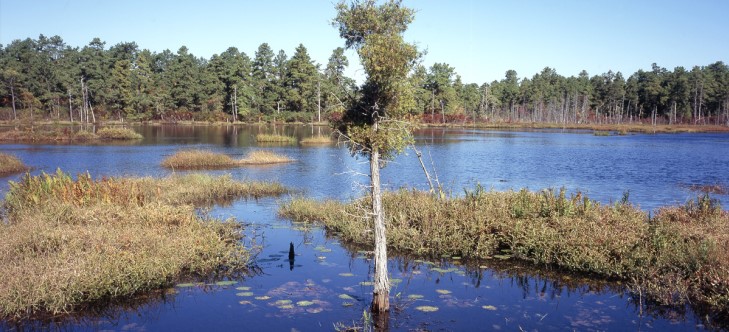by Alison Mitchell, Co-Executive Director, New Jersey Conservation Foundation
For the past 20 years, a New Jersey organization not widely known among the general public has been making a big environmental impact through dozens of projects aimed at restoring and enhancing the state’s wetlands – ecosystems that are critical allies in the global fight against climate change.
The New Jersey Corporate Wetlands Restoration Partnership (NJCWRP) – a unique public-private organization composed of businesses, nonprofits, academic groups and government agencies – was recently recognized by the state Department of Environmental Protection (DEP) for its successful efforts to restore the health of over 1,000 acres of wetlands and 70 miles of streams.
Its projects have ranged from creating habitat for endangered bog turtles, to removing dams to allow migrating fish species free passage to upstream spawning areas, to flood control projects to protect residents of urban communities.
“The New Jersey Corporate Wetlands Restoration Partnership has been steadfastly and quietly at work helping to preserve the ecosystems that provide tremendous richness and wildlife diversity to the Garden State,” said DEP Commissioner Shawn LaTourette during the partnership’s October meeting. “Their work and other efforts such as this have taken on an even higher level of urgency in the face of climate change.”
The NJCWRP brings together 34 companies, four business associations, 19 nonprofit and academic organizations, and 12 government agencies, which work collaboratively to advance projects to protect, restore and enhance wetlands.
Wetlands, long protected by state and federal laws, are an incredibly valuable natural resource. They purify water by filtering out harmful pollutants, reduce flood risk by soaking up rainwater from storms, provide rich wildlife habitat, and offer incredible beauty and recreational opportunities. Their wet soils are excellent for storing carbon, making them instrumental in mitigating the impacts of climate change.
But to be effective, wetlands need to be healthy. That’s where the Corporate Wetlands Restoration Partnership comes in.
The New Jersey chapter was founded in 2003 as part of former President George H.W. Bush’s Coastal America Partnership project to protect, preserve and restore coastal ecosystems.
At its peak, the Coastal America Partnership had 14 state Corporate Wetlands Restoration Partnership chapters. Unfortunately, the New Jersey chapter is the only one remaining today. As such, it separated from the Coastal America Partnership earlier this year and became an independent New Jersey nonprofit.
The good news is that the New Jersey Corporate Wetlands Restoration Partnership is thriving, with membership, funding and participation of members at an all-time high. The partnership has grown over the past two decades to become a model of sustainability and good corporate citizenship.
“We’re proud that NJCWRP is viewed by our government partners as a model for the nation in its approach to preserving, enhancing and protecting New Jersey’s wetlands and aquatic habitats,” said NJCWRP Chair Rob Pollock.
One of the keys to NJCWRP’s success is the leadership of PSEG, which has been at the helm of the partnership since its founding. Another is its diverse membership, representing many interests and points of view.
All members of the NJCWRP are required to pay dues or in-kind contributions to support projects, and all have a vote in which projects are ultimately chosen for funding.
“Everyone has some skin in the game as far as contributing, and everyone has a vote,” said Jim Shissias, who is retired from PSEG and still helps out as a consultant for the partnership.
Eligible projects must be either on public land, or land owned by a nonprofit organization. In recent years, said Shissias, an increase in extreme weather has led to a more intense focus on how natural lands can buffer and protect communities. As a result, many new NJCWRP projects target funds toward natural lands projects to provide communities greater protection from storms.
One recently-approved project is the restoration of land along the Trotters Branch of the Elizabeth River in the City of Elizabeth, in Union County. The Trotters Branch Nature Preserve, and accompanying tributary, represents the last remaining stand of eastern deciduous forest within all of Elizabeth, consisting of approximately 3.5 acres embedded within the 8-acre Phil Rizzuto Park.
Another recent NJCWRP initiative is the Scotch Bonnet Island Marsh Elevation Enhancement project, in Stone Harbor, Cape May County, which will use clean dredged material to stabilize a failing marsh platform and reverse acreage loss in the marsh.
Congratulations to the New Jersey Corporate Wetlands Restoration Partnership for two decades of working toward a healthier environment in this state we’re in. New Jersey Conservation Foundation is proud to be part of this innovative, forward-looking collaborative.
Since its inception, the NJCWRP has received more than $1.6 million in contributions and pledges of in-kind services from its members. These donations have resulted in 59 projects totaling more than $21.6 million that have aided in the preservation, restoration, enhancement and protection of more than 1,000 acres of aquatic habitats and 70 stream miles.
To learn about preserving New Jersey’s land and natural resources – including wetlands, streams and marshes – visit the New Jersey Conservation Foundation website at www.njconservation.org or contact me at www.njconservation.org.

